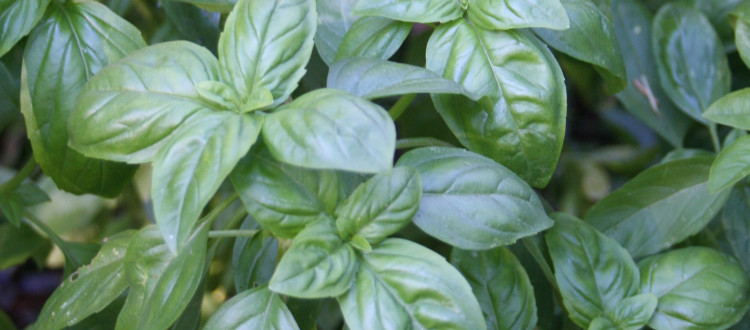Basil
Basil (Ocimum basilicum) is a popular summer annual with large aromatic green leaves on soft branching stems and usually grows 18-24 inches tall. The most popular varieties are Sweet Basil and Genovese. The flavor of Sweet basil is floral and mild, with slightly minty notes, licorice-like aroma with clove-like undertones. Gevovese basil is less temperamental and more pungent than Sweet Basil with a spicy, licorice and clove-like flavor and leaves are best used fresh in pestos or caprese, since it has a tendency to become bitter with long, slow cooking periods.
Other basil varieties include Thai basil, lemon basil and cinnamon basil. Thai basil has a more assertive flavor than Sweet Basil, while cinnamon basil is milder with a hint of cinnamon.
How to Plant
Basil can be grown from seed sown directly in the ground, but it’s best planted in the garden from starts well after danger of frost has passed and the soil has warmed up. Nighttime temperatures in the spring can affect the plants, especially on the coast. Basil should be planted in a sunny spot with rich but somewhat loamy, well-drained soil. It is susceptible to fusarium wilt which occurs in many soils and will attack basil while not seeming to bother anything else. The key is to let the soil dry out to the touch 2-3 inches down, once established. Always water in the morning, being careful to keep water off of the leaves. Make sure the plants have good air circulation to discourage downy mildew. Pinch back the tips and any flower buds to encourage growth for a fuller, bushier plant and to increase your your harvest.
Fertilizing
Use a high nitrogen blend fertilizer such as 8-2-4 regularly to maintain strong, healthy foliar growth.
Harvesting
Snip stems of basil as needed. Basil leaves are very delicate and bruise easily; handle with care. Wash and chop just before using. Basil is easily dried for storage, but chopped basil leaves can also be frozen in olive oil cubes for a taste of summer when summer has passed.
Varieties We Sell
- African Blue Basil
African blue basil is hybrid of East African basil and a garden variety called dark opal. Considered more of a decorative basil, it is edible although it has a slightly camphor-clove like flavor. Attracts bees. - Bolloso Napoletano
Basil from Naples, strong flavor, great for pesto, 6″ leaves. - Fino Nano Compatto
Miniature leaves perfect for containers. Aromatic, spicier than Italian basils. - Fino Verde
Flavorful, small leaved basil with a tall upright bushy habit. It has a few leaf forms within the strain. Keep flower buds pinched back. - Genovese
This Italian variety has extremely tender, fragrant, extra-large leaves and is superb for pesto. More vigorous and easier to grow than other basil varieties. - Greek Columnar
This variety has smaller leaves and an upright growth habit with overtones of cinnamon in its aroma. Better for dishes with long cooking times — generally not used for pesto. Tall growth habit, up to 3 feet, very upright and does not flower. - Tiguillio Italian
“Genovese” type with round spoon leaves. Suitable for pots. Superior aroma and flavor for pesto or fresh use, good disease resistance. - Sweet Basil
Traditional Italian favorite used fresh, to flavor vinegar, and as the main ingredient for pesto.
Recommendation for Use
- Basil is a key ingredient for tomato sauces, pesto, salad dressings and the ever-popular Italian appetizer with fresh tomatoes and mozzarella
- Basil is often used in Mediterranean zucchini and eggplant dishes
- Thai basil is a key ingredient in many Thai and Vietnamese dishes
Recipes: Classic Basil Pesto, Fresh Basil Vinaigrette

